You may have noticed that Google Analytics 4 (GA4) has a new cookie consent setting. GA4 has even started to show banners that alert you to set up the cookie consent process.
Read on to find out what it is all about, whether it could apply to you and what tools you can use to make your life a bit easier.
What is cookie consent?
Cookies

Cookies in the digital world are small amounts of code (not the tasty treat) stored on a browser to remember someone. It helps to understand what location they are in and their browsing habits.
First-party cookies are the ones Google Analytics uses, whereas Third-party cookies are the types that remember you from one site to the next. Third-party cookies are on the way out as privacy laws worldwide prevent their usage.
First-party cookies are less restricted. However, many countries are starting to legislate requirements for consent following the European Union and their General Data Protection Regulation (GDPR) laws.
Cookie consent
It involves telling people that cookies are collected and stored on the website and the user’s browser.
The website then gives the person the decision whether to agree to the cookies or opt-out.
Some sites do this and still let the cookies or tracking pixels, e.g. Google Analytics, fire. However, compliance with the European Union and selected countries’ laws only occurs when a user agrees to it to avoid any penalties.
The cookies help to let tools like Google Analytics know whether you’ve been to the website before.
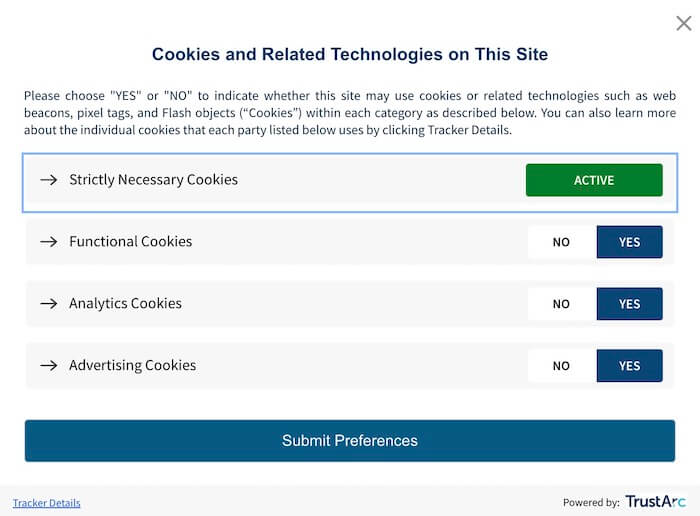
Do I need cookie consent for Google Analytics 4?
Cookie consent settings are for sites that do business or market to the European Union or Economic Area. In addition, some other countries have adopted similar policies.
The following countries require cookie consent:
- Argentina
- Austria
- Belgium
- Brazil
- Bulgaria
- Canada
- Croatia
- Cyprus
- Czech Republic
- Denmark
- Estonia
- Finland
- France
- Germany
- Greece
- Hungary
- Iceland
- Ireland
- Italy
- Latvia
- Liechtenstein
- Lithuania
- Luxembourg
- Malta
- Mexico
- Nigeria
- Netherlands
- Norway
- Poland
- Portugal
- Romania
- Saudi Arabia
- Singapore
- Slovakia
- Slovenia
- Spain
- Sweden
- United Kingdom
- United States of America – Conneticut
Some differences apply to the policy and requirements by country.
Other countries – Australia, USA etc.
In Australia, cookie consent banners are not required. Still, consider a Privacy Policy outlining how you collect, store and manage cookies/tracking on your website.
In the United States of America, California requires that users are informed about the collection of cookies. However, gaining consent is only necessary if you plan to sell the data to a third party.
In Virginia, the rules are based on opt-outs only. If you provide a consent banner (not required) and they opt out, you must meet that need.
In Colorado, cookie consent is required when collecting sensitive personal information or info related to a child. Similarly, Utah laws also have a child information policy.
South Africa‘s consent policy applies to those processing data or operating physically in their country.
Although Switzerland does not need cookie consent, the likelihood that companies will be targeting other impacted EU nations means you likely need to.
Updated: March 2024
Do I require a cookie consent banner if I am in Australia?
You do not require a cookie consent banner if your target market is outside the regions requiring cookie consent.
Suppose you do not set up the cookie consent settings. In that case, Google Analytics will sample or remove user data from the impacted regions. Although it only states the European Union and Economic Area, this is likely to change in future.
If you think the data of these users is still valuable to you, consider a cookie consent banner that shows only to these users and complies with Google Analytics needs.
How does Google Cookie Consent V2 work?
Google introduced a new version of their cookie consent offering. The use of cookie consent for impacted regions will be mandatory starting in March 2024.
There are two different modes:
Basic mode: only data from visitors who say yes to tracking is processed in Google Analytics 4 and Google Ads. Those who say no or provide no response will have no data shared.
Advanced mode: visitors who say yes to tracking will be processed in Google Analytics 4 and Google Ads. Those who say no or provide no response will have data shared with Google Analytics 4 and Google Ads, but only about device type, conversion type, time of day and country. This data will allow Google Analytics to apply estimates to the traffic results, known as modelling.
Suppose you operate or advertise to the impacted countries. In that case, you should consult a lawyer to determine whether you can use Advanced mode.
How do I enable cookie consent on my website?
Several tools exist to make this easier. The best practice is to have cookie consent v2 if it applies to your region or preference and to use a cookie consent management platform (CMP).
Pancedetes – Shopify
Shopify has said they are in the final stages of building a solution into stores but have yet to roll out the change, specifics or an official date.
However, if you need to comply in the interim, you can use the Pancedetes plugin. Depending on your requirements, you’ll need the $90 USD per year (~$140 Australian Dollars) Plus option. The Google consent mode does not come with the free plan.
WebToffee GDPR Cookie Consent – WordPress
A popular GDPR-compliant cookie consent tool is WebToffee. The plugin costs $69 USD annually (~$105 Australian Dollars). It also supports multi-lingual sites, which is a bonus.
GTM4WP – WordPress
Our favourite plugin for Google Analytics installations is GTM4WP. In the plugin settings, under Integrations > Cookie consent mode, you can fire off specific tags or parameters to comply with the Google consent settings for your chosen platform.
Web Toffee GDPR Cookie Consent plugin also has a setting in GTM4WP that you can tick to turn on when you have that plugin running on your website.
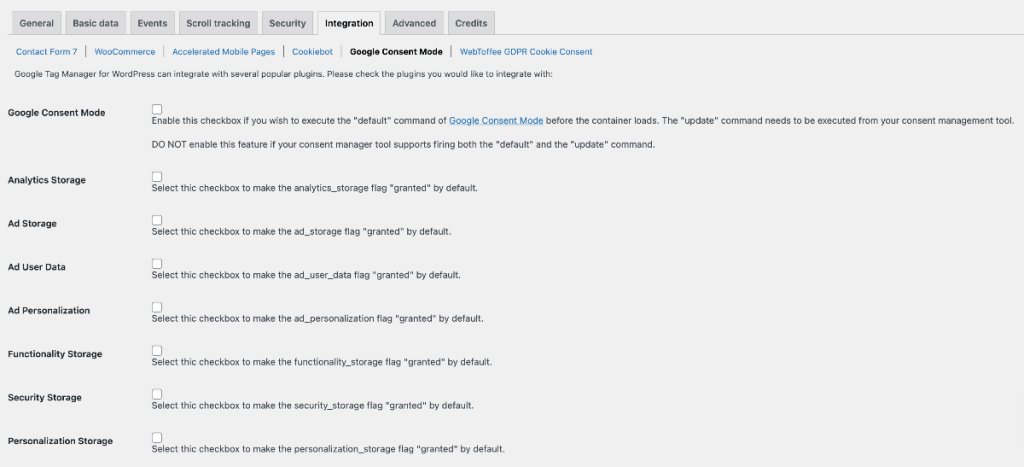
CookieYes – Any content system
CookieYes is another popular option. It has a plugin for WordPress and Shopify users. For other sites like Kajabi, Squarespace, and Magento, to name a few, you would add the cookie tool by adding a piece of code to your <head> tag.
Unlike other tools, a free option allows sites to enjoy Google cookie consent mode for up to 25,000 page views per month. You won’t be able to change the branding of the pop-up, though. The custom brand paid option starts monthly at $10 USD (~$15 Australian Dollars).
Cookie Information – Any content system
Cookie information starts from around 15 euros (~$25 Australian Dollars) per month, so it comes at a higher price.
The tool has plugins available for WordPress and Wix. Plus, it can be integrated with systems like Shopify, Magento, Squarespace and Google Tag Manager using a <head> tag.
What settings should you use in Google Analytics 4?
The admin section of Google Analytics 4 contains further information about the cookie consent settings and using a cookie consent management platform (CMP).
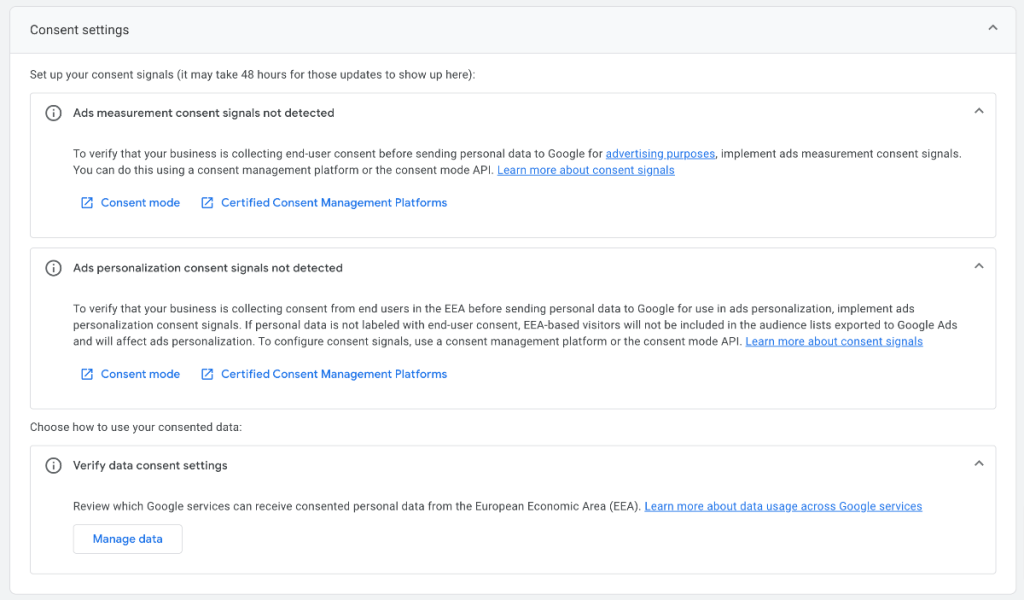
Go to Admin (gear icon bottom left side) > look for “Data collection and modification” > Data streams > select your website/stream, and you’ll see the heading “Consent settings”.
There is also a setting section where you can define which Google services should apply the consent tag.
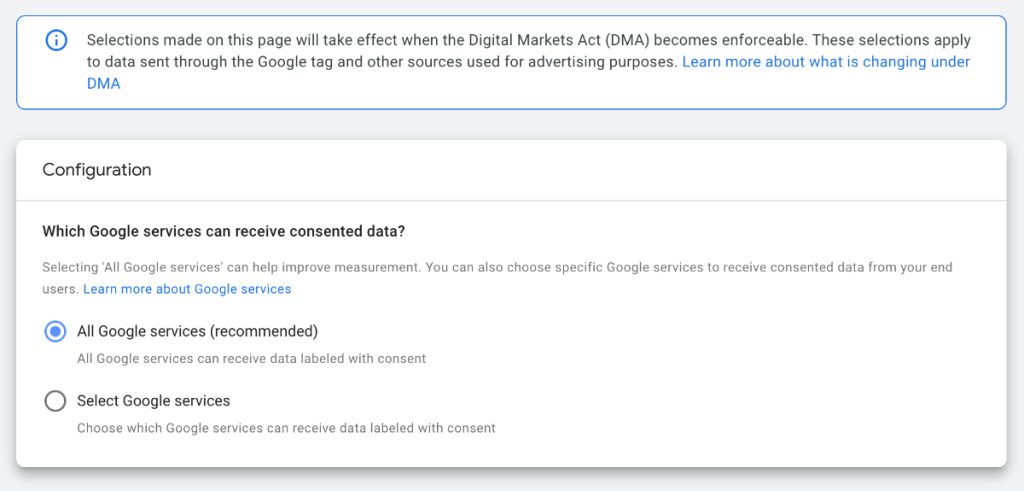
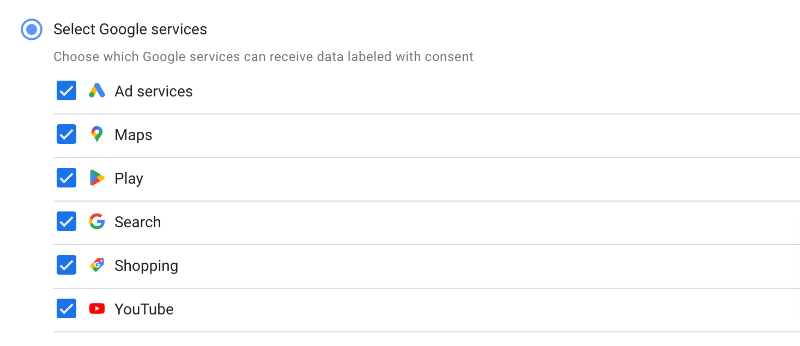
Need help setting up cookie consent?
As Google Tag Manager specialists and Google Analytics experts, we can help you set up cookie consent for your website.
We recommend you speak to a lawyer like Pod Legal for advice on whether cookie consent rules apply and what your obligations are as a business or website owner.
Disclaimer: The information presented was correct based on research undertaken at the time of collection to the best of our care and abilities. We are not liable nor responsible for the information provided and do not claim that it is factually correct or accurate. Consider independent research before making any decisions.













